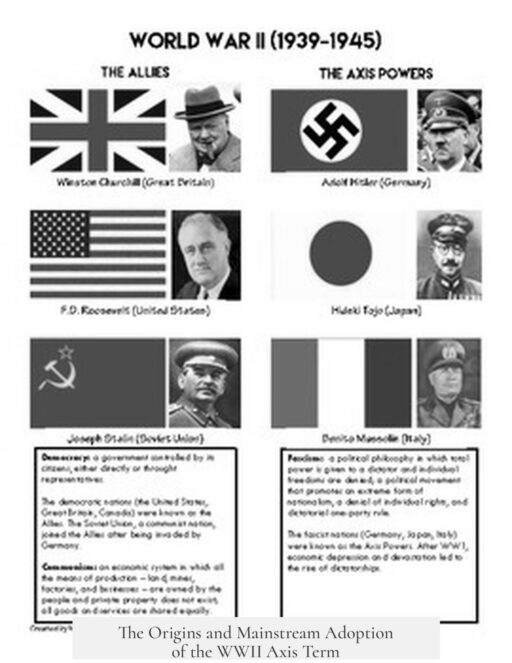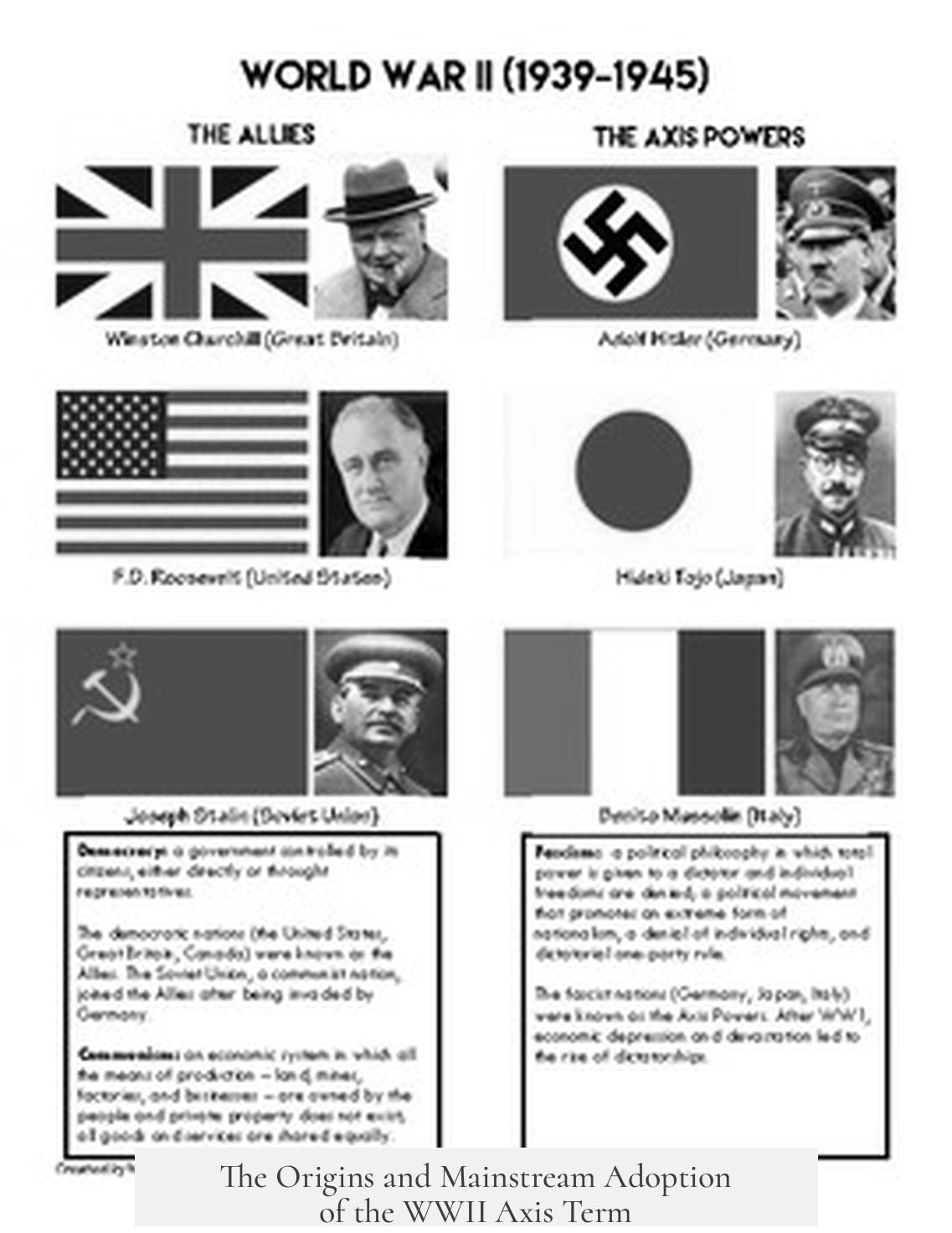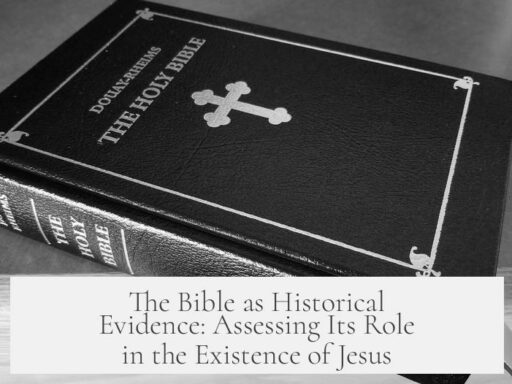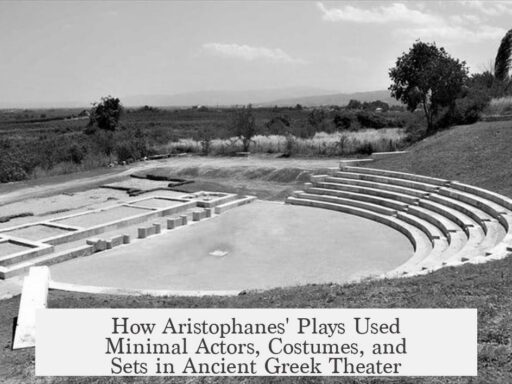The Axis Powers in WWII are called the “Axis” because the term originated from a 1936 speech by Benito Mussolini, who described the bilateral treaty between Italy and Germany as forming a central “axis” around which European states could cooperate. This label suggested these powers were not merely allied but represented a new geopolitical pivot restructuring world order. The term became mainstream through Western press usage and diplomatic references by the late 1930s, especially after Italy formally entered World War II in 1940.
In his 1936 speech in Milan, Mussolini coined the term “Axis” to depict the Rome-Berlin connection. He said this agreement was “not a dividing-line but rather an axis around which all European states animated by the will to cooperation and peace can collaborate.” This framing challenged the idea that the two countries were simply dividing the world into spheres, instead proposing a new central spine in global power. The term axis, inherently neutral and scientific—as in an axis of rotation—took on political symbolism through fascist ideology.
This axis metaphor implied permanence and stability in the emerging alliance. Mussolini and Hitler saw themselves as leading nations that had been marginalized by existing power structures. The “Axis” was thus not only a geographic or diplomatic concept but a symbol of a fascist-led new order meant to replace the status quo. The rhetoric carried a dark tone of intimidation, signaling that those opposed to fascism stood outside this new political center.
The term gained traction when the Anglo-American press and diplomatic circles began referring to “the Rome-Berlin Axis”. Newspapers often used the phrase to describe the growing political and military cooperation between Germany and Italy. U.S. State Department reports from the late 1930s also referenced the “Rome-Berlin Axis”, showing its adoption in official discourse.
- The phrase’s popularity increased notably towards the end of the 1930s.
- It peaked in frequency after Italy entered the war in spring 1940.
Japan’s formal alliance with Germany and Italy expanded the axis concept into the “Rome-Berlin-Tokyo Axis.” Although this extended name was less common, it reflected the tri-nation pact solidifying the Axis Powers. Allied propaganda and war reporting further popularized the phrase “Axis,” using it to clearly identify the coalition opposed to the Allies.
Interestingly, German propaganda tended to avoid the term “Axis.” Nazi officials preferred to describe their alliance as a coalition of European civilization standing against what they framed as threats from Anglo-American capitalism and Soviet communism. This narrative excluded the explicit use of “Axis,” which they saw as more of an Italian framing. Instead, Nazi propaganda focused on racial and ideological themes that contrast with the straightforward geopolitical term Mussolini popularized.
| Aspect | Details |
|---|---|
| Origin | 1936 Mussolini speech in Milan; term describes Rome-Berlin treaty |
| Meaning | Axis as a central line symbolizing a new geopolitical order |
| Popularization | Western press and diplomatic reports in late 1930s, peaks in 1940 |
| Expansion | Inclusion of Japan led to “Rome-Berlin-Tokyo Axis” |
| German stance | Generally avoided term; emphasized ideological rhetoric instead |
The “Axis” label emerged as a powerful symbol more than a mere alliance name. It represented the fascist vision of a world order revolving around the nationalist powers of Germany, Italy, and later Japan. Its widespread adoption by Western media and Allied propaganda cemented its place in history. Meanwhile, Axis leaders infused the term with ideological meaning, underscoring their goal of reshaping global power.
- The Axis term originated with Mussolini in 1936 describing Rome-Berlin cooperation.
- It symbolized a new central pivot of fascist-aligned powers in Europe.
- The phrase gained mainstream use in Western media and diplomacy before 1940.
- Japan’s alliance expanded the term to “Rome-Berlin-Tokyo Axis.”
- Germans typically avoided the term in their own propaganda narratives.
Why Are the Axis in WWII Called the Axis and When Did That Name Become Mainstream?

Simply put, the Axis in WWII are called the Axis because of a 1936 speech by Benito Mussolini, who described the cooperation between Italy and Germany as a kind of “axis” around which European states could revolve. The term gained traction in media and diplomacy shortly after, especially as the alliance expanded, becoming mainstream by the late 1930s and early 1940s.
Sounds straightforward, right? But there’s a fascinating story behind this seemingly simple term.
The Birth of the “Axis” Idea: Not Just a Line, But a Pivot
Back in 1936, Benito Mussolini dropped a phrase that historians love to dissect. Speaking in Milan, he said the treaty signed by Italy and Germany was not “a dividing line” but “an axis around which all European states animated by the will to cooperation and peace can collaborate.”
Here’s the kicker: the word “axis” in everyday language is pretty neutral—it refers to something like a central line a planet spins around. But Mussolini used it as a metaphor for something much bigger. He framed Italy and Germany as a central pivot reshaping the political world. It wasn’t just a friendly handshake; it was Mussolini’s way of pitching a new world order in which fascist states held the power.
Hitler loved this idea too, calling the German-Italian relationship an “axis between two peoples,” a bond deeper than a mere political alliance. This axis implied permanence, a fundamental shift in balance, and a serious, almost ominous, partnership aiming to redraw global influence.
Sinister Overtones and Fascist Intimidation
Let’s be clear: the term wasn’t just benign political jargon. It carried a threatening vibe. Mussolini’s rhetoric suggested this axis wasn’t just cooperation but a foundation for spreading fascism. If you weren’t with this axis, you were outside a new global order explicitly hostile to your beliefs. That’s a heavy message tucked inside a simple word.
From Speech to Headlines: How the Axis Name Spread
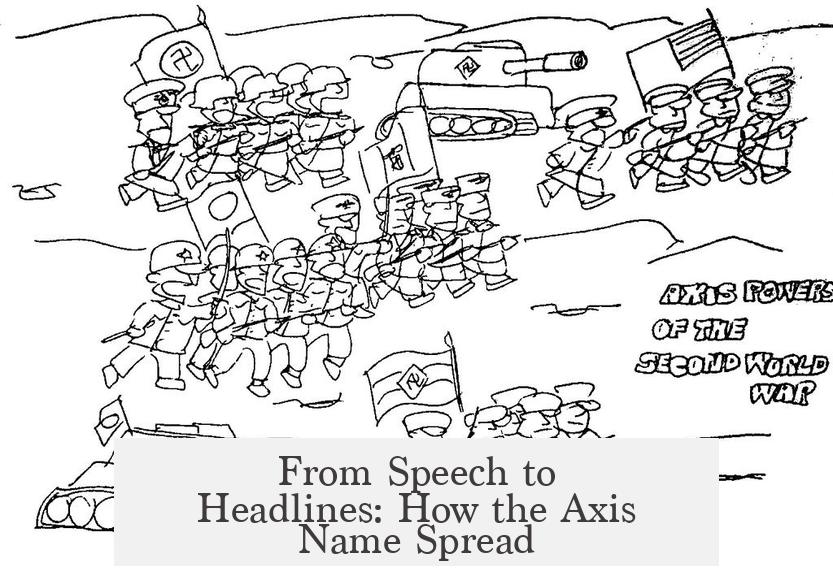
But how did this term leap from a dictator’s speech to everyday conversation?
The answer is media and diplomatic circles. Western newspapers—especially in the Anglo-American world—started using “Rome-Berlin Axis” to describe Germany and Italy’s tight bond. It popped up in official U.S. State Department reports and diplomatic correspondence, adding a layer of legitimacy. This was no longer just fascist propaganda; it was the international way to describe this alliance.
Google Ngram data shows that “Rome-Berlin Axis” usage spiked in the late 1930s, peaking when Italy officially entered WWII in 1940. This timing isn’t a coincidence. With the alliance turning into a formidable power bloc, news outlets needed a catchy label, and “Axis” fit the bill perfectly.
Japan Joins the Party: The Rome-Berlin-Tokyo Axis
Japan’s alliance with Germany and Italy stretched the axis concept further. The phrase “Rome-Berlin-Tokyo Axis” started circulating but was less common than the original or the simplified “Axis” nickname. Still, it emphasized the global reach of the alliance and helped cement the term in the public imagination.
Interestingly, after Japan joined the pact, Allied forces cranked up the Axis language for propaganda. The word became a potent symbol of the enemy coalition, used in everything from newspapers to war propaganda posters.
What Did the Germans Think of the Term “Axis”?
Surprisingly, Nazi Germany’s own propaganda avoided using “Axis.” They preferred casting their alliance as a united front defending “civilized Europe” against the threats of “Anglo-American mammonism” and “Soviet Bolshevism.” This phrase echoed deep anti-Semitic conspiracy theories prevalent in Nazi ideology.
“Axis” was more a label imposed from outside, popularized by Western media and diplomats. Germany painted a grander, moralistic picture of their war effort, contrasting it with the blunt militaristic term “Axis.”
So, What’s the Big Deal About This Name?

Understanding why the Axis is called the Axis reveals the power of language in shaping history. The term is a prime example of how political rhetoric, media influence, and international diplomacy intertwine. Mussolini’s speech marked an ideological boldness, signaling fascist ambitions. The West’s adoption of the term helped encapsulate a dangerous alliance in a simple word that stuck through history.
Imagine if Mussolini had called it the “Revolving Line” or “Powerbridge” instead. Would the world have thought about WW2 alliances differently? Language frames perception and sometimes even the course of events.
Practical Takeaways: What To Remember
- The term “Axis” originated from Mussolini’s metaphor in 1936, not from wartime propaganda alone. His speech framed the alliance as a pivot, emphasizing its permanence and ideological weight.
- Western press and diplomatic use propelled the term to mainstream recognition by the late 1930s. Official government reports and newspapers normalized the phrase.
- Japan’s later entrance expanded the concept to the “Rome-Berlin-Tokyo Axis,” reflecting a global alliance. Allied propaganda further popularized the term, cementing it in public memory.
- Germany rarely used the term “Axis” themselves. Nazi propaganda preferred grand narratives justifying their actions rather than borrowing Mussolini’s term.
- The term carried a sinister political message. It wasn’t just descriptive but intimidating—drawing lines between fascist “insiders” and others.
Final Thoughts
Names matter, especially in history. The “Axis” label encapsulates the period’s shifting alliances and reveals the fascists’ vision for a new world order. It reminds us how language can carry immense ideological and emotional weight. When hearing the word “Axis” today, now you know it started with a speech about a vertical line—not just a military alliance, but a bold statement of power and ambition.
Next time you hear about the Axis powers, ask yourself: who benefits from naming things this way? Who decided this label? And how might history sound if we rewrote its vocabulary?
Why were the WWII Axis powers called the “Axis”?
The term “Axis” originated from Mussolini’s 1936 speech. He described the treaty with Germany as a vertical line or axis between Rome and Berlin. This symbolized a new geopolitical order linking the two countries.
When did the name “Axis” become widely used?
The term gained popularity in the late 1930s. Western press and diplomatic reports began using Rome-Berlin Axis. It peaked around 1940 when Italy entered the war.
Did Japan’s alliance affect the use of the term “Axis”?
Yes. When Japan joined Germany and Italy, the phrase expanded to Rome-Berlin-Tokyo Axis. This longer form was less common but helped popularize the word.
How did the Allies use the term “Axis” during the war?
Allied media and propaganda spread the use of “Axis.” It described enemy cooperation and framed the Axis as a unified fascist threat.
Did Germany use the word “Axis” in their propaganda?
No. Germans avoided the word. Nazi propaganda described their alliance as a defense for Europe against Anglo-American capitalism and Soviet communism.
